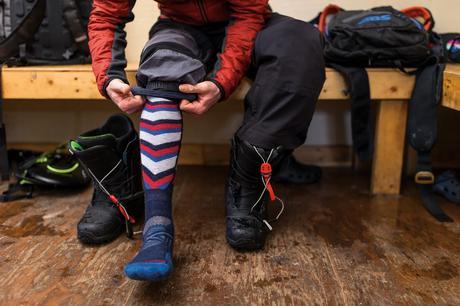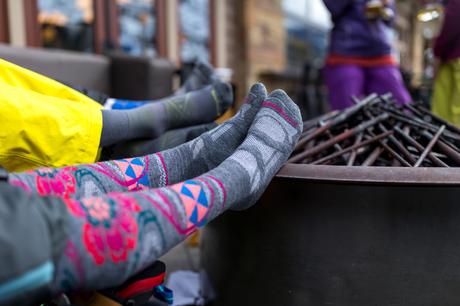Socks are an important but often overlooked part of your outfit for the piste, especially if you consider you will be on your feet all day, in freezing conditions and often in less than comfortable footwear. A good pair of ski socks will keep you warm, cushioned and offer support while allowing your feet to breathe. A bad pair could mean an unpleasant day on the slopes. If you’re baffled by the choices available, and need a little advice, then make sure you have happy feet this season with our helpful guide to choosing the right pair of ski socks for you.

Size and Shape
It goes without saying but choosing the right size sock is essential for comfort. Ski socks come in a range of shapes and sizes, whether it’s a one-size-fits-all tube sock or an anatomically shaped size-specific one. Usually this is reflected in the price and seasoned snow lovers may generally want to invest more than occasional skiers and newcomers to the slopes.
Tube socks are the most basic kind of sock available and come with a lower price tag than the more performance-tailored styles. Consisting of an elasticated tube of fabric with a toe cap and an elasticated cuff to hold it in place, tube socks are single size, non-gender specific and offer simple comfort for both adults and children alike.
Ergonomic ski socks are shaped to fit the contours of the foot and often come in men’s and women’s styles, with a heel and an angled toe box that may also be left or right foot specific. These socks are often available in different sizes and offer a higher level of performance as well as a better fit. We would normally recommend choosing the size that corresponds to your usual shoe size, or if your shoe size falls in the boundary between two sock sizes then we would suggest going smaller. For example, if you are a UK size 8.5 and the sock is available in sizes 6-8 and 9-12, the smaller size will offer a tighter fit and prevent fabric from bunching and rubbing (which may cause blisters).
Natural vs Synthetic
Ski socks are available in a range of synthetic and natural fibres, each with their own characteristics and qualities. Most are made from a blend of materials to achieve the right balance between stretch, warmth, comfort and moisture wicking properties.
Synthetic materials are a comfortable option at the lower end of the price range, but also have their own benefits. Stretch fabrics such as Lycra and elastics are great at retaining their shape, extending the life of the sock, and help keep the sock in place. Nylon is a durable fiber ideal for reinforcing areas susceptible to wear and tear and has added antibacterial properties for fresher smelling feet.
Wool is naturally moisture wicking, ensuring feet stay dry throughout the day, and is both warm and durable. Bulkier than synthetic materials, this material also has less elasticity so it may lose its shape over time.
Merino wool is an especially high quality wool with superior warmth and breathability. Exceptionally soft and comfortable, this natural fiber is at the higher end of the price range but offers great performance in terms of shape retention, odour prevention and the all-important ability to keep feet warm and dry.

Weight Divisions
Lightweight ski socks are the preferred choice of experienced skiers, offering the highest level of performance thanks to increased control and a better fit with high end fitted ski boots. Ideal for racing as well as warmer weather skiing, these socks are cooler and give the wearer a better feel of what their feet are doing.
Midweight socks are the most popular choice for many skiers, delivering a balance between the warmth and comfort of a thicker sock and the performance of a lightweight sock. The extra padding throughout makes them ideal for less experienced skiers while still giving them flexible movement.
Heavyweight socks offer more comfort and are better suited to beginners and casual skiers. Their thicker padding means extra warmth for anyone who suffers with cold feet on the piste as well as additional cushioning against ski boots.
Additional Features
Cushioning and padding in key areas that are affected by repeated impact or pressure, such as the instep, ankle and shins, help alleviate discomfort and pain that may develop during the day. If you’re new to skiing you may want to choose a sock with more cushioning, especially if you’re using rented ski boots.
Compression ski socks, like regular compression socks, work by applying pressure in certain areas to increase blood flow to the legs and feet. This reduces fatigue and improves stamina out on the slopes, as well as shortening recovery time and helping you to avoid tired, heavy legs after a day of sport.
Support comes in the form of thicker, tighter or more elasticated fabric in the areas that need it, such as the arch and ankle, and is designed to help hold your foot in a natural position and prevent injuries and discomfort while skiing.
Ventilation zones on a ski sock may be made from mesh or particularly breathable fabric and help to regulate the temperature of the foot and improve both breathability and moisture management, preventing feet from overheating and becoming damp after a long day of activity.
So whether you’re a budding skier or just looking to update your skiwear, you should have a better idea of what to look for when buying socks to suit you, your abilities and your destination.
You can shop our men’s ski socks here, our women’s ski socks here and our kid’s ski socks here.
